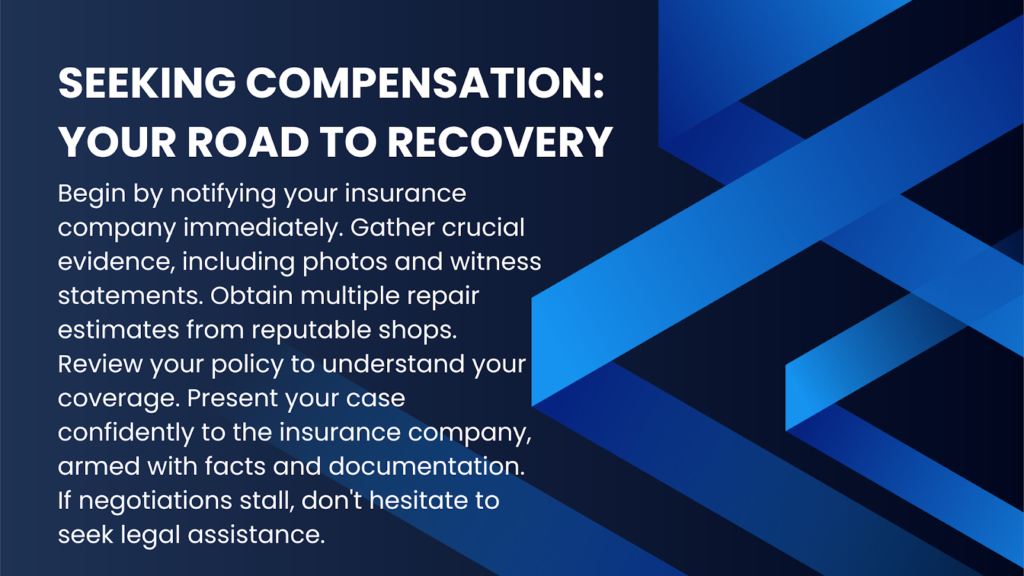
Every 60 seconds, 13 car accidents occur in the United States, a significant portion of which are T-bone collisions.
These side-impact crashes can cause extensive property damage, leaving victims grappling with financial burdens and complex insurance claims.
If you’ve been involved in a T-bone accident in Alabama, understanding your rights and the process of seeking compensation for property damage is crucial for your recovery.
Understanding T-Bone Accidents
T-bone accidents, also known as side-impact collisions, occur when the front of one vehicle collides with the side of another, forming a “T” shape.
These accidents often happen at intersections, parking lots, or when a driver fails to yield the right of way.
Common Causes of T-Bone Accidents
- Running red lights or stop signs;
- Distracted driving;
- Failure to yield right of way;
- Speeding;
- Drunk or impaired driving; and
- Poor weather conditions affecting visibility or traction.
T-bone accidents can result in severe property damage due to the vulnerable nature of a vehicle’s side.
Understanding the common causes can help you navigate the compensation process and establish liability in your case.
Assessing Property Damage in T-Bone Accidents
After a T-bone collision, it’s essential to thoroughly document and assess the damage to your vehicle. This information will be crucial when seeking compensation.
Steps to Assess Property Damage
- Safety first: Ensure you’re out of harm’s way before inspecting your vehicle.
- Document the scene: Take photos and videos of both vehicles, focusing on the point of impact and surrounding damage.
- Gather information: Exchange insurance and contact details with the other driver.
- File a police report: This official document can serve as valuable evidence.
- Get a professional assessment: Have a certified mechanic evaluate the full extent of the damage.
Remember, some damage may not be immediately visible. Internal structural damage or misalignment issues can significantly impact your vehicle’s safety and value.
Types of Property Damage in T-Bone Accidents
T-bone accidents can cause various types of property damage, each with its own implications for compensation.
Common Types of Vehicle Damage
- Body damage: Dents, scratches, and structural deformities
- Frame damage: Misalignment or bending of the vehicle’s frame
- Mechanical damage: Engine, transmission, or suspension issues
- Electrical system damage: Wiring problems or malfunctioning components
- Glass damage: Shattered windows or windshield
- Interior damage: Airbag deployment, torn upholstery, or damaged dashboard
Understanding these categories can help you communicate effectively with insurance adjusters and ensure all aspects of damage are considered in your claim.
Alabama Laws Regarding Property Damage Compensation
Alabama’s legal framework plays a crucial role in determining how property damage claims are handled after a T-bone accident.
Key Points of Alabama Property Damage Law
- Statute of Limitations: You have two years from the date of the accident to file a property damage lawsuit.
- Contributory Negligence: Alabama follows a strict contributory negligence rule, which can affect your ability to recover damages if you’re found partially at fault.
- Minimum Insurance Requirements: Alabama requires drivers to carry at least $25,000 in property damage liability coverage.
Familiarizing yourself with these laws can help you navigate the compensation process more effectively and avoid potential pitfalls.
Steps to Seek Compensation for Property Damage
Securing fair compensation for property damage after a T-bone accident involves several key steps.
Here’s a roadmap to guide you through the process:
- Notify your insurance company: Report the accident as soon as possible.
- Gather evidence: Collect photos, witness statements, and the police report.
- Get repair estimates: Obtain quotes from multiple reputable repair shops.
- Understand your coverage: Review your insurance policy to know what’s covered.
- Negotiate with the insurance company: Present your evidence and advocate for fair compensation.
- Consider legal assistance: If negotiations stall, consult with an attorney specializing in property damage claims.
Following these steps systematically can increase your chances of receiving adequate compensation for your damaged property.

Calculating Property Damage Compensation
Determining the appropriate amount of compensation for property damage involves several factors. Understanding these can help you ensure you’re not shortchanged in your claim.
Factors Influencing Compensation Amount
- Cost of repairs;
- Diminished value of the vehicle;
- Rental car expenses during repairs;
- Towing and storage fees; and
- Personal property damaged in the vehicle.
It’s important to consider both immediate and long-term costs when calculating your compensation claim.
Don’t overlook factors like diminished value, which can significantly impact your vehicle’s resale value even after repairs.
Dealing With Insurance Companies
Navigating insurance claims after a T-bone accident can be challenging.
Here are some tips to help you effectively communicate with insurance companies:
- Be prompt in your communication;
- Keep detailed records of all interactions;
- Understand your policy coverage;
- Don’t accept the first offer without scrutiny;
- Consider getting an independent appraisal; and
- Be cautious about giving recorded statements.
Remember, insurance companies aim to minimize payouts. Stay informed and assertive throughout the process to protect your interests.
Common Challenges in Property Damage Claims
Seeking compensation for property damage after a T-bone accident can present several obstacles. Being aware of these challenges can help you prepare and overcome them.
Potential Roadblocks in the Claims Process
- Disputes over fault;
- Lowball settlement offers;
- Delays in claim processing;
- Disagreements over repair costs or methods;
- Issues with diminished value calculations; and
- Complications with uninsured or underinsured drivers.
If you encounter these challenges, don’t hesitate to seek professional legal advice to protect your rights and ensure fair compensation.
The Role of Legal Representation
While many property damage claims can be resolved without legal intervention, some situations may benefit from the expertise of an attorney.
When to Consider Legal Assistance
- Complex liability issues;
- Significant property damage or total loss;
- Disputes with insurance companies;
- Cases involving uninsured or underinsured drivers; and
- Concerns about the statute of limitations.
An experienced attorney can navigate complex legal issues, negotiate with insurance companies, and ensure you receive fair compensation for your property damage.
Preventing T-Bone Accidents: Safety Tips
While seeking compensation is important, preventing T-bone accidents is even more crucial.
Here are some safety tips to reduce your risk:
- Always obey traffic signals and signs;
- Look both ways before entering intersections;
- Be cautious when turning left at intersections;
- Avoid distractions while driving;
- Maintain a safe speed, especially in poor weather conditions; and
- Be aware of blind spots when changing lanes.
By following these safety practices, you can significantly reduce your risk of being involved in a T-bone accident and the resulting property damage.
Frequently Asked Questions
To address common concerns about T-bone accidents and property damage compensation, here are answers to some frequently asked questions.
How Long Do I Have to File a Property Damage Claim After a T-Bone Accident in Alabama?
In Alabama, you have two years from the date of the accident to file a property damage lawsuit.
What If the Other Driver Is Uninsured?
If you have uninsured motorist coverage, you can file a claim with your own insurance company. Otherwise, you may need to pursue legal action against the uninsured driver directly.
Can I Seek Compensation for a Rental Car While My Vehicle Is Being Repaired?
Yes, rental car expenses are often covered as part of your property damage claim, especially if the other driver was at fault.
What Is “Diminished Value,” and Can I Claim It?
Diminished value refers to the reduction in your vehicle’s market value after an accident, even after repairs. In Alabama, you may be able to claim diminished value as part of your property damage compensation.
Should I Accept the Insurance Company’s First Offer?
It’s generally advisable to review the offer carefully and negotiate if you believe it doesn’t fully cover your damages. Consider getting an independent assessment before accepting any offer.
Take Action: Protect Your Rights and Secure Fair Compensation
Have you been involved in a T-bone accident in Alabama and need help seeking compensation for property damage?
Don’t navigate this complex process alone. At Baxley Maniscalco, our experienced attorneys specialize in handling property damage claims resulting from T-bone accidents.
We understand the intricacies of Alabama law and can guide you through every step of the compensation process.
Contact Baxley Maniscalco today for a free consultation. Our dedicated team will review your case, explain your rights, and fight tirelessly to ensure you receive the full compensation you deserve for your property damage.
Can't find what you're looking for? Search our site below.










